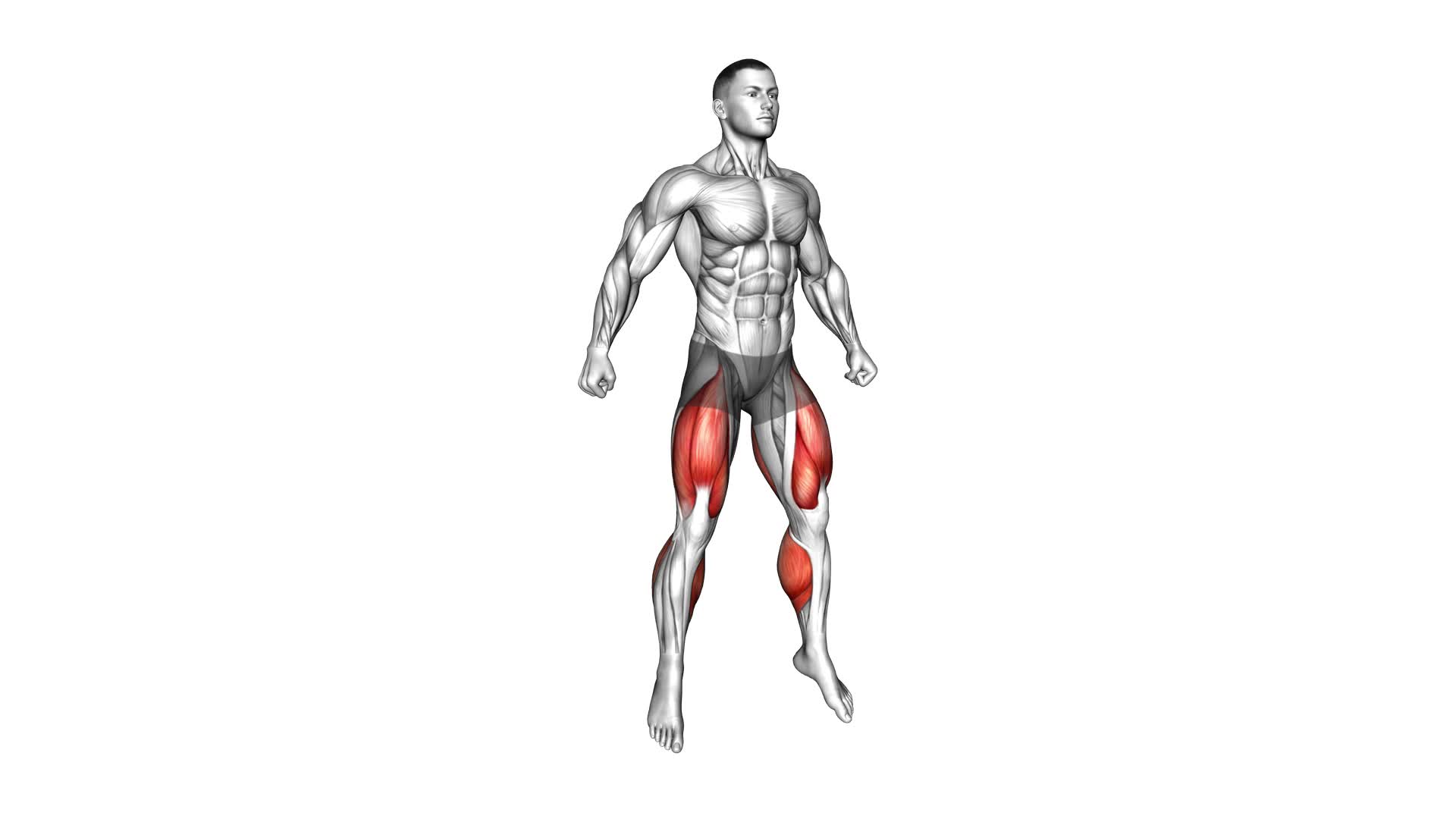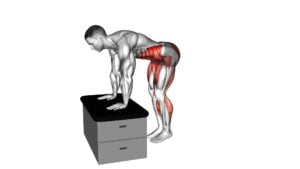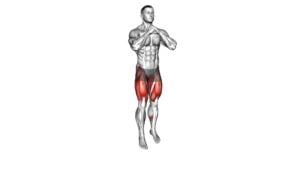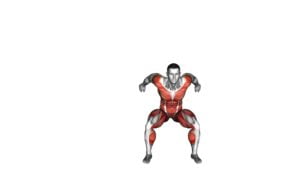Mini Squat Hop (male) – Video Exercise Guide & Tips

Looking to amp up your workout routine? Check out this video exercise guide and tips for the mini squat hop!
Watch This Exercise Video
In just a few minutes a day, you can reap the benefits of this dynamic exercise. Learn the proper form and technique, avoid common mistakes, and discover modifications and variations to challenge yourself.
Maximize the effectiveness of the mini squat hop with expert tips.
Get ready to squat, hop, and feel the burn!
Key Takeaways
- The Mini Squat Hop is beneficial for improving lower body strength, burning calories, enhancing balance and coordination, and increasing explosiveness and power.
- Proper form and technique, such as maintaining foot placement and avoiding common mistakes, are crucial for effective Mini Squat Hop.
- Common mistakes to avoid include not squatting low enough, relying on arm power instead of leg power, using incorrect landing technique, and improper breathing techniques.
- Modifications and variations, such as weighted squat jumps and single-leg squat jumps, can be used to increase resistance and target specific muscle groups.
Benefits of the Mini Squat Hop
You can experience numerous benefits from incorporating the Mini Squat Hop into your exercise routine. This exercise offers several advantages that can contribute to your overall fitness and help you achieve better results.
One of the main benefits of the Mini Squat Hop is its ability to improve lower body strength. By performing this exercise, you engage your quadriceps, hamstrings, glutes, and calves, which can lead to stronger and more toned muscles in your legs.
Additionally, the Mini Squat Hop is a high-intensity exercise, which means it can help you burn calories and increase your cardiovascular endurance, resulting in weight loss and improved stamina.
Another advantage of this exercise is its impact on your balance and coordination. The Mini Squat Hop requires you to maintain stability and control as you jump from a squat position, which can enhance your overall body control.
Moreover, incorporating this exercise into your routine can help improve your explosiveness and power, as it involves a quick and explosive movement.
Proper Form and Technique for the Mini Squat Hop
When performing the mini squat hop, proper foot placement is crucial to maintain balance and maximize effectiveness. Placing your feet hip-width apart and ensuring that your weight is evenly distributed will help you maintain stability throughout the exercise.
Additionally, it's important to avoid common mistakes such as allowing your knees to collapse inward or lifting your heels off the ground, as these can lead to potential injury and diminish the benefits of the mini squat hop.
Foot Placement Importance
To achieve proper form and technique for the Mini Squat Hop, focus on the precise placement of your feet. The positioning of your feet plays a crucial role in maintaining balance and maximizing the effectiveness of this exercise.
Here are different foot placement techniques for mini squat hops:
- Feet shoulder-width apart: This is the standard foot placement for mini squat hops. It provides a stable base and allows for balanced movement.
- Toes pointed slightly outwards: Angling your toes outward can engage different muscles in your legs and provide a deeper squat.
- Toes pointed straight ahead: Keeping your toes parallel to each other can help target specific muscles, such as the quads and glutes.
- Heel-to-toe placement: Placing your heel slightly in front of your toes can increase stability and help you maintain balance throughout the exercise.
Remember to experiment with different foot placements to find what works best for you, and always prioritize proper form and technique to prevent injuries and maximize the benefits of the Mini Squat Hop.
Common Mistakes to Avoid
Maintaining proper form and technique for the Mini Squat Hop is essential to avoid common mistakes and maximize the effectiveness of the exercise.
One common mistake to avoid isn't squatting low enough. To perform the Mini Squat Hop correctly, make sure to lower your body into a deep squat position, with your thighs parallel to the ground.
Another mistake is using your arms to generate momentum instead of relying on the power of your legs. Remember to engage your leg muscles and use them to propel yourself upwards, rather than relying on your upper body.
Lastly, be mindful of your landing technique. Avoid landing with your knees locked or collapsing inward. Instead, land softly and maintain stability by keeping your knees aligned with your toes.
Common Mistakes to Avoid During the Mini Squat Hop
To maximize your results and prevent injury during the Mini Squat Hop, it's crucial that you focus on avoiding these common mistakes:
- Improper breathing techniques: Breathing plays a vital role in any exercise, including the mini squat hop. Avoid holding your breath or shallow breathing. Instead, inhale deeply through your nose during the squat portion and exhale forcefully through your mouth as you explode into the jump.
- Lack of muscle activation: It's essential to activate the correct muscles during the mini squat hop to ensure proper form and effectiveness. Engage your glutes, quadriceps, and calf muscles throughout the movement. Failing to activate these muscles can lead to poor performance and potential strain on other muscle groups.
- Landing with locked knees: Landing with locked knees puts unnecessary stress on your joints and increases the risk of injury. Remember to soften your knees upon landing, allowing them to absorb the impact and distribute the force evenly.
- Insufficient depth in the squat: A common mistake isn't going deep enough into the squat position. Aim to lower your hips until they're parallel to the ground or slightly below. This ensures that you're engaging the muscles properly and maximizing the benefits of the exercise.
By avoiding these mistakes, you can optimize your mini squat hop routine, improve your form, and reduce the risk of injury.
Now, let's explore some modifications and variations for the mini squat hop.
Modifications and Variations for the Mini Squat Hop
To enhance your Mini Squat Hop routine, consider implementing modifications and variations for added challenge and variety.
By incorporating squat jump modifications, you can amplify the intensity of your workout. One modification you can try is the weighted squat jump, where you hold a dumbbell or kettlebell at your chest while performing the exercise. This increases the resistance and engages your muscles even more.
Another modification is the single-leg squat jump, which targets your glutes and quadriceps while also improving balance and stability.
For those seeking advanced mini squat variations, there are a few options to consider. One variation is the plyometric squat jump, where you explode upwards as high as possible and land softly in a squat position. This explosive movement enhances power and agility.
Another variation is the lateral squat jump, where you jump laterally from side to side, targeting your inner and outer thighs. This variation adds a dynamic element to your routine and challenges your coordination.
Remember to always maintain proper form and technique when performing these modifications and variations. Start with lighter weights and gradually increase the difficulty as you become more comfortable and confident.
Incorporating these modifications and variations into your Mini Squat Hop routine will help you maximize your gains and keep your workouts engaging and effective.
Tips for Maximizing the Effectiveness of the Mini Squat Hop
To get the most out of your Mini Squat Hop routine, focus on your form and technique. Here are some tips to help maximize the effectiveness of this exercise:
- Choose the right footwear: Wearing proper shoes can provide stability and support during the Mini Squat Hop. Opt for athletic shoes with good cushioning and grip to prevent slips and injuries.
- Pay attention to your breathing: Proper breathing technique is crucial for any exercise. Inhale deeply through your nose as you lower into the squat position, and exhale forcefully through your mouth as you explode upwards into the hop. This helps to oxygenate your muscles and improve your power output.
- Engage your core: Keep your abdominal muscles tight throughout the exercise. This helps to stabilize your body and protect your lower back.
- Maintain proper form: Start by standing with your feet shoulder-width apart, toes slightly turned out. As you squat down, keep your knees in line with your toes and push your hips back. Explode upwards with a jump, landing softly on the balls of your feet.
By following these tips, you can ensure that you're getting the most out of your Mini Squat Hop routine. Remember to listen to your body and adjust the intensity as needed.
Happy hopping!
Sample Mini Squat Hop Workout Routine
Now that you know how to maximize the effectiveness of the Mini Squat Hop, how can you incorporate it into a sample workout routine?
The Mini Squat Hop is a versatile exercise that can be easily integrated into your existing workout regimen. Here is a sample Mini Squat Hop workout routine that you can try:
- Warm-up: Start with a five-minute warm-up consisting of light cardio exercises like jogging or jumping jacks to get your muscles ready for the workout.
- Mini Squat Hop: Perform three sets of 10-12 repetitions of the Mini Squat Hop. You can vary the intensity by increasing or decreasing the height of your jump.
- Superset: Pair the Mini Squat Hop with another lower body exercise such as lunges or squats. Perform three sets of 10-12 repetitions for each exercise, alternating between the two without rest.
- Mini Squat Hop variations: To add variety to your routine, incorporate different variations of the Mini Squat Hop, such as side-to-side jumps or forward-backward jumps. Aim for three sets of 10-12 repetitions for each variation.
- Cool-down: Finish your workout with a five-minute cool-down, focusing on stretching your leg muscles to prevent tightness and promote recovery.
Frequently Asked Questions
How Many Calories Can You Burn by Doing the Mini Squat Hop?
By doing the mini squat hop, you can burn a significant number of calories. This exercise is a knee-friendly option that helps you engage multiple muscle groups and elevate your heart rate.
It's an effective way to increase your calorie burn and improve your cardiovascular endurance. Incorporating mini squat hops into your workout routine can contribute to your overall calorie-burning goals while providing a low-impact, knee-friendly exercise option.
Can the Mini Squat Hop Help Improve Vertical Jump Height?
The mini squat hop can be an effective exercise for improving vertical jump height. Incorporating vertical jump training into your workout routine can help enhance your explosive power and leg strength.
Plyometric exercises like the mini squat hop can specifically target the muscles used in jumping, leading to increased jump height over time. By consistently incorporating this exercise into your training, you can see significant improvements in your vertical jump abilities.
Is the Mini Squat Hop Suitable for People With Knee Injuries?
If you have knee injuries, the mini squat hop may not be suitable for you. It's important to find modifications for knee-friendly squat exercises that won't exacerbate your condition.
There are alternatives to the mini squat hop that can still help improve your vertical jump height without putting unnecessary strain on your knees.
It's crucial to prioritize your safety and consult with a medical professional or a certified trainer to find the best exercises for your specific needs.
Can the Mini Squat Hop Be Done Without Any Equipment?
Yes, you can definitely do the mini squat hop without any equipment. It's a great exercise that targets your lower body strength.
If you don't have access to equipment, there are alternative exercises you can try, such as bodyweight squats or lunges.
The mini squat hop helps to improve your leg muscles and overall lower body strength. It's a simple yet effective exercise that can be done anywhere.
Are There Any Specific Breathing Techniques to Follow While Performing the Mini Squat Hop?
When performing the mini squat hop, it's important to focus on your breathing techniques and maintain proper form.
By controlling your breath, you can enhance your stability and power during the exercise. Take a deep breath in before you squat down, and exhale as you jump up. This helps engage your core and maximize your effort.
Remember to maintain proper form throughout the movement to prevent injury and get the most out of your workout.
Conclusion
In conclusion, the mini squat hop is an effective exercise for building lower body strength and improving cardiovascular fitness. By maintaining proper form and avoiding common mistakes, you can maximize the effectiveness of this exercise.
Additionally, there are modifications and variations available to suit different fitness levels and goals. Incorporating the mini squat hop into your workout routine can help you achieve your fitness goals and enhance athletic performance.

Author
Years ago, the spark of my life’s passion ignited in my mind the moment I stepped into the local gym for the first time. The inaugural bead of perspiration, the initial endeavor, the very first surge of endorphins, and a sense of pride that washed over me post-workout marked the beginning of my deep-seated interest in strength sports, fitness, and sports nutrition. This very curiosity blossomed rapidly into a profound fascination, propelling me to earn a Master’s degree in Physical Education from the Academy of Physical Education in Krakow, followed by a Sports Manager diploma from the Jagiellonian University. My journey of growth led me to gain more specialized qualifications, such as being a certified personal trainer with a focus on sports dietetics, a lifeguard, and an instructor for wellness and corrective gymnastics. Theoretical knowledge paired seamlessly with practical experience, reinforcing my belief that the transformation of individuals under my guidance was also a reflection of my personal growth. This belief holds true even today. Each day, I strive to push the boundaries and explore new realms. These realms gently elevate me to greater heights. The unique combination of passion for my field and the continuous quest for growth fuels my drive to break new ground.







